Yalamurra, a “garden of survivors” in South Australia offers Texas inspiration
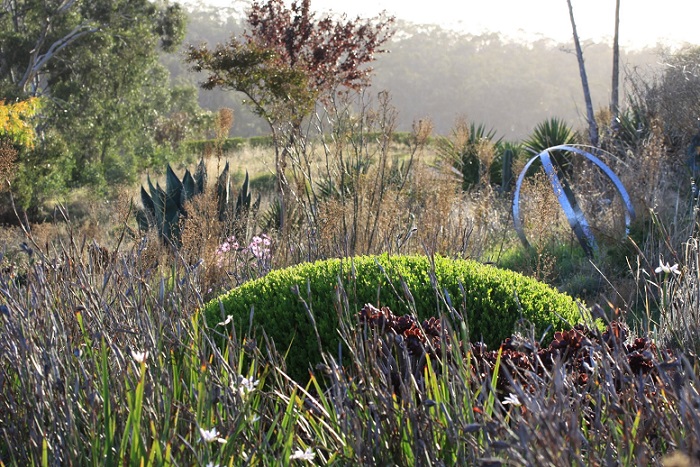
Want to know what’s inspiring me this week? It’s the South Australian garden of Kurt Wilkinson, a professional gardener and topiarist in the Adelaide area. Kurt’s work came to my attention via a Danger Garden post about Gardening Australia, a TV show from Down Under with episodes viewable online. The “Yalamurra” episode about Kurt’s garden caught Danger’s eye, and boy, did it grab mine as well.
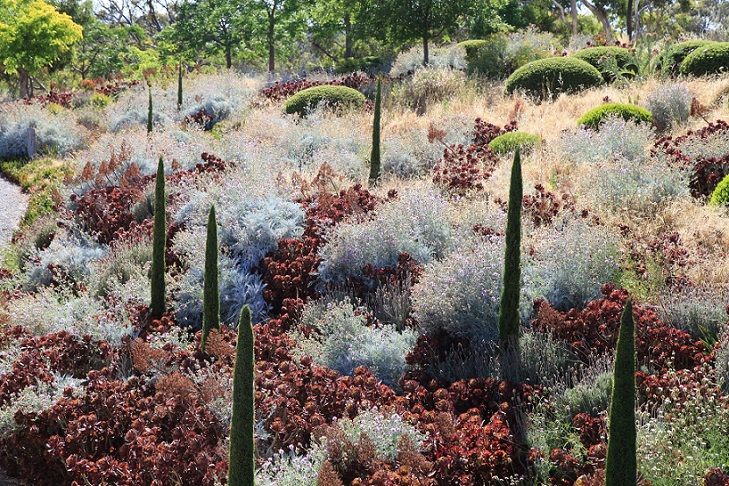
The first thing that struck me about Kurt’s garden is a feeling of sympathy with our own Texas Hill Country landscape. Hilly, rocky, scrubby, and hot, his property northeast of Adelaide presented him, he says, with the necessity of ditching familiar garden plants and experimenting with tough natives and roadside weeds to see what would live. Sound familiar, my fellow Texans?
The second thing that struck me is his use of clipped topiary to add structure and punctuation amid airier, dry-loving plants that grow in a meadowy matrix with native grasses.
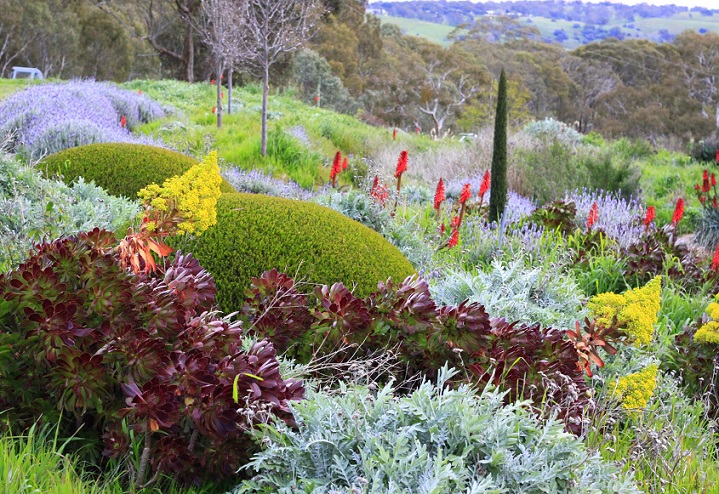
Here in central Texas, with our sauna-like but drought-prone summers — unlike Kurt’s dry Mediterranean summers — we can’t always successfully grow the fabulous maroon aeoniums he favors for foliage color, nor his rivers of lavender. But look, we have our own unique and well-adapted plants that we can use to similar effect. Pop some zig-zagging, lead-the-eye topiary spheres or spires in there, and it’s magic.
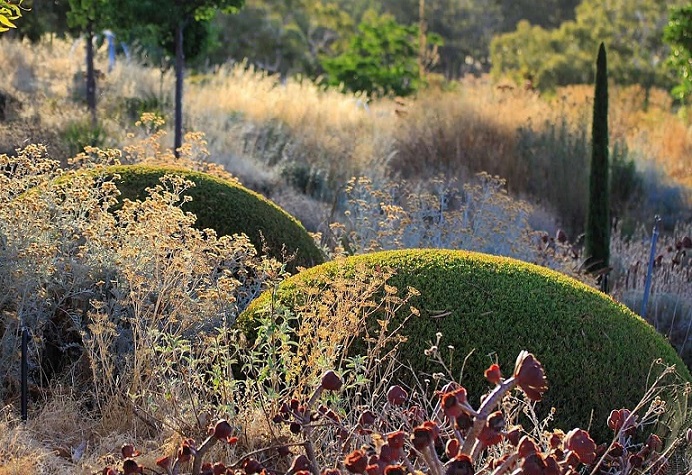
I reached out to Kurt on Instagram (check out his stunning images of his garden), and he kindly agreed to send me some photos to use in this post. When I asked if he’d ever been to Texas, he replied, “I have never visited any other gardens other than those I work in, in Adelaide. I do visit gardens vicariously through books, YouTube and Insta but that’s it.” Instead he focuses intently on his own plot of land, trying out anything that occurs to him and seeing what works. He also works hard on his photography skills, and it shows.
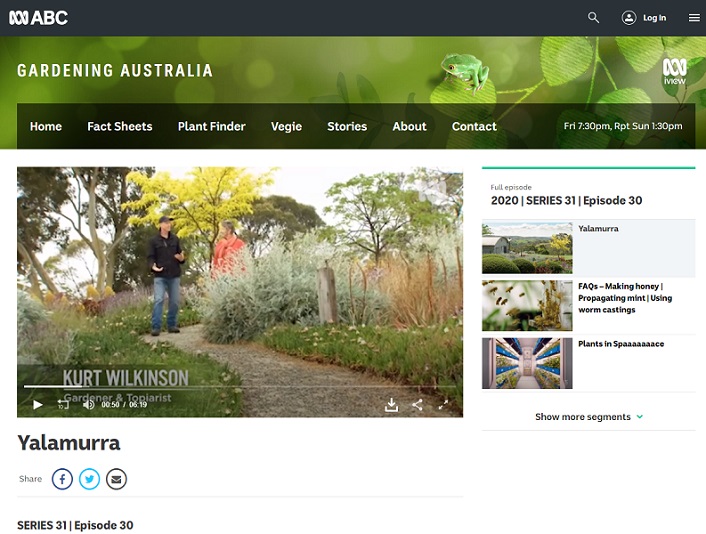
After watching his segment on Gardening Australia, I looked for more and found an article in Country Style magazine and a fascinating, in-depth interview with Kurt on the podcast Horticulture Rising. There I learned that Kurt is a self-taught gardener with a predilection for topiary and hedges. When he and his wife moved to their current home, he found himself gardening in a climate quite different from where he gardens for clients. So he needed a new plant palette for his thin soil and hot summers. As he says on the podcast, “I’m a professional plant killer. What’s left is just what has survived….I can’t be babying plants.”
Formerly he favored formal gardens. But now that he’s growing what desert garden designer Steve Martino appreciatively calls “weeds,” he blends native, tough-as-nails plants with the formal topiary elements. And he’s not afraid to topiary natives to see what happens, which reminds me of former Austin designer (now based in Santa Fe) James David, who once showed me an oak he’d topiaried. Kurt says, “Once you understand a plant, then you can really start getting creative with it.”
Pruning advice
Kurt believes in trimming plants regularly, even the “pencil pines,” aka Italian cypresses, that most people allow to grow into tall spires. He controls their height and diameter by starting young with side trimming and staying on top of their growth. Don’t let them grow to the size you want and then start trimming, he advises. Instead, trim them tight from the start and then let them expand to the desired size amid regular pruning. “Don’t be scared of the plant,” he says. “Cut it hard. Just do it.” For demonstrations, check out his pruning videos on his YouTube channel.
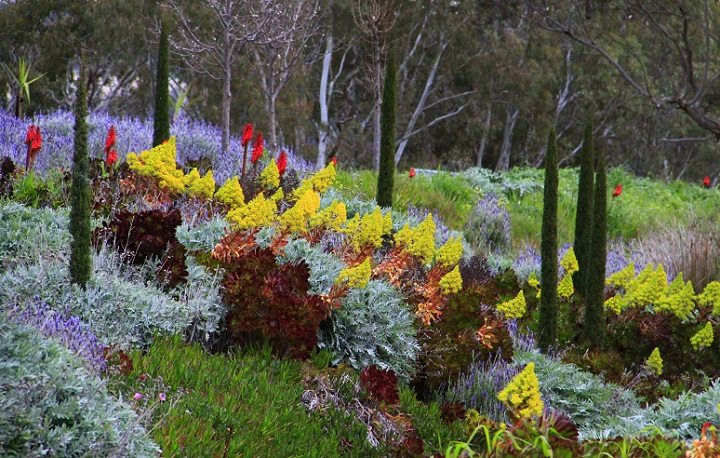
I learned a lot about experimentation with plants, finding one’s own way with what works, and just the sheer joy of playing with plants from my deep-dive yesterday into Kurt’s gardening world. Dive in yourself, and see how it inspires you.
Photos courtesy of Kurt Wilkinson. My thanks for their use.
__________________________
Digging Deeper
Come learn about gardening and design at Garden Spark! I organize in-person talks by inspiring designers, landscape architects, authors, and gardeners a few times a year in Austin. These are limited-attendance events that sell out quickly, so join the Garden Spark email list to be notified in advance; simply click this link and ask to be added. Season 8 kicks off in fall 2024. Stay tuned for more info!
All material © 2025 by Pam Penick for Digging. Unauthorized reproduction prohibited.


Yay! Thanks for expanding upon what I’d seen and loved of Kurt’s garden. Part of me was afraid to share Gardening Australia for fear they’d shut down access if too many people tuned in—like how we (those of us that do) have to quickly tune into posted episodes of BBC Gardener’s World before they’re quickly taken down.
Well, that would suck. I didn’t know about the situation with the BBC show.
The maroon succulents are aeonium arboreum atropurpureum, not euphorbia.
Of course! Thanks for the correction, Walt. I should have known that, but, well, that’s one we can’t grow either. A gorgeous plant though.
I love this so much. He’s really taken what is good about formal gardens and mixed it up into a design that is dynamic . Can’t wait to watch this !
Exactly. Those green mounds rising up through the grasses and perennials are stunning.
This is very interesting (even if I’m not drawn to topiary). I’ve already added him to my IG feed.
No topiary for you?? I’m crazy for it amid all my grasses and airier plants and plan to add a couple more spheres this winter.
Glad to hear your method for that, Pam. I love spires and also clean lined topiary but I struggle with inserting them. I think fluff at the base is key?? Front of the border, versus back? These questions keep me awake.
Just discovered recently that “austral” means southern. Kept wondering why native Baptisia australis was named for another continent!
These are good questions, Julie, and I’m far from the topiary expert to ask. I have been inspired by contemporary gardens here in Austin that use the strong geometry of topiary balls as accents or amid native grasses and perennials. Jackson Broussard’s garden, for example: https://www.penick.net/digging/?p=45546. So when I saw Kurt’s style, it really spoke to me as well. I like topiary at corners of beds or inserted in the middle, anchoring airier plants.
I have 2 blue point junipers in their nursery pots waiting for me to get up the nerve to make them into spiral topiaries. I feel inspired! But I’m thinking I may need to wait until more spring-ish weather comes to Central TX.
Have fun with your topiarying! (If that’s a word.)
This is just what I needed to see on this blustery snowy day. I love those tall skinny punctuation marks!
It does warm the soul to see his stunning garden photos. Enjoy, Lisa!
I was struck by his style too, which reminds me of Nicole de Vesian a bit. And those clipped shrubs do have a counterpart with the result of wind effects, goat grazing…Makes me wonder if I could have kept the Monterey cypresses trimmed from the get-go!
I love that you made that connection, Denise, about naturally mounded plants due to wind or animal grazing. There’s a place for topiary in naturalistic gardens, for sure!